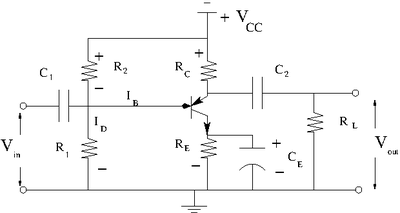Difference between revisions of "TF EIMLab14 Writeup"
| Line 19: | Line 19: | ||
so <math>V_{CC} < 40</math> | so <math>V_{CC} < 40</math> | ||
| − | To set this collector current you ned to choose V_{CC} and R_C to give 0.5 mA and be in the middle of the load line. | + | To set this collector current you ned to choose <math>V_{CC}</math> and <math>R_C</math> to give 0.5 mA and be in the middle of the load line. |
| − | From previous lab we should try V_{CE} = 1 Volt | + | From previous lab we should try <math>V_{CE} = 1 Volt</math> |
Loop theorem \Rightarrow | Loop theorem \Rightarrow | ||
Latest revision as of 23:15, 15 March 2018
The Common Emitter Amplifier
Circuit
1.)Construct the common emitter amplifier circuit below according to your type of emitter.
2.)Calculate all the R and C values to use in the circuit such that
- a. Try
- b. mA DC with no input signal
- c. V
- d. to prevent burnout
= 40 Volts
so
To set this collector current you ned to choose and to give 0.5 mA and be in the middle of the load line.
From previous lab we should try
Loop theorem \Rightarrow
- Since
Unknowns are and
Let V_{CC} = 10 Volts
- e.
- f. mA
3.)Draw a load line using the -vs- from the previous lab 13. Record the value of or .
4.)Set a DC operating point so it will amplify the input pulse given to you. Some of you will have sinusoidal pulses others will have positive or negative only pulses.
5.)Measure all DC voltages in the circuit and compare with the predicted values.(10 pnts)
6.)Measure the voltage gain as a function of frequency and compare to the theoretical value.(10 pnts)
7.)Measure and at about 1 kHz and compare to the theoretical value.(10 pnts)
How do you do this? Add resistor in front of which you vary to determine and then do a similar thing for except the variable reistor goes from to ground.
8.)Measure and as a function of frequency with removed.(10 pnts)
Questions
- Why does a flat load line produce a high voltage gain and a steep load line a high current gain? (10 pnts)
- What would be a good operating point an an common emitter amplifier used to amplify negative pulses?(10 pnts)
- What will the values of , , and be if the transistor burns out resulting in infinite resistance. Check with measurement.(10 pnts)
- What will the values of , , and be if the transistor burns out resulting in near ZERO resistance (ie short). Check with measurement.(10 pnts)
- Predict the change in the value of if is increased from 10 to 50 (10 pnts)
- Sketch the AC equivalent circuit of the common emitter amplifier.(10 pnts)
